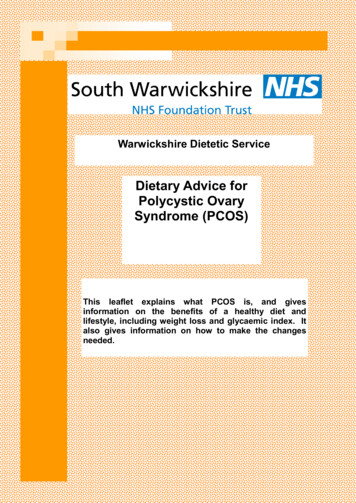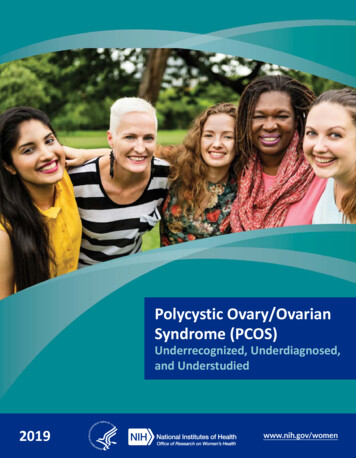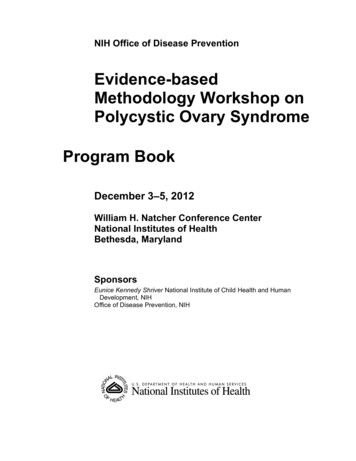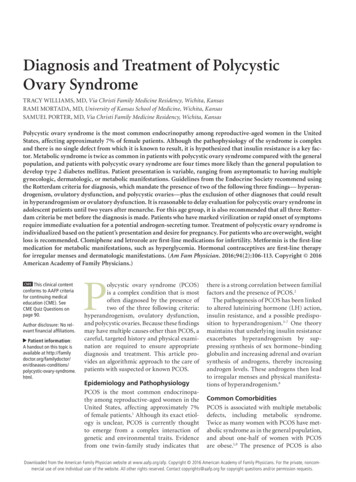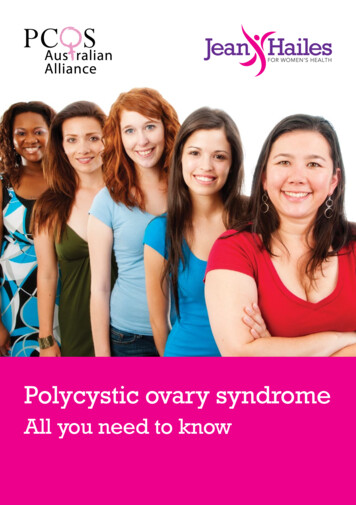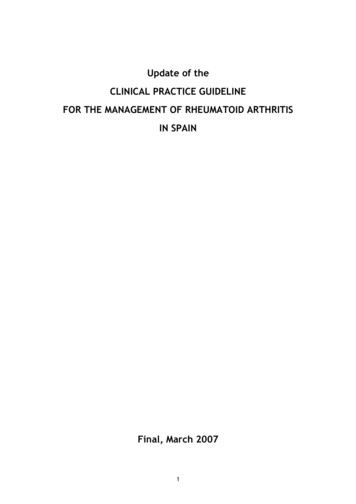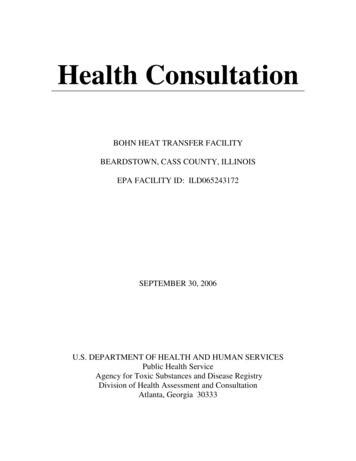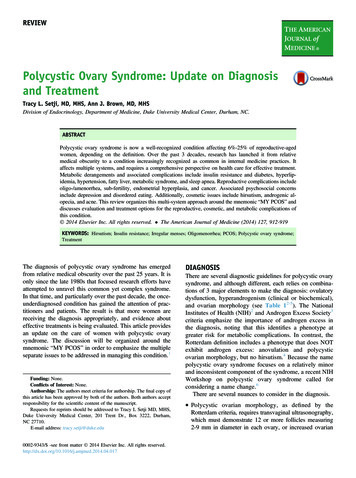
Transcription
REVIEWPolycystic Ovary Syndrome: Update on Diagnosisand TreatmentTracy L. Setji, MD, MHS, Ann J. Brown, MD, MHSDivision of Endocrinology, Department of Medicine, Duke University Medical Center, Durham, NC.ABSTRACTPolycystic ovary syndrome is now a well-recognized condition affecting 6%-25% of reproductive-agedwomen, depending on the definition. Over the past 3 decades, research has launched it from relativemedical obscurity to a condition increasingly recognized as common in internal medicine practices. Itaffects multiple systems, and requires a comprehensive perspective on health care for effective treatment.Metabolic derangements and associated complications include insulin resistance and diabetes, hyperlipidemia, hypertension, fatty liver, metabolic syndrome, and sleep apnea. Reproductive complications includeoligo-/amenorrhea, sub-fertility, endometrial hyperplasia, and cancer. Associated psychosocial concernsinclude depression and disordered eating. Additionally, cosmetic issues include hirsutism, androgenic alopecia, and acne. This review organizes this multi-system approach around the mnemonic “MY PCOS” anddiscusses evaluation and treatment options for the reproductive, cosmetic, and metabolic complications ofthis condition.Ó 2014 Elsevier Inc. All rights reserved. The American Journal of Medicine (2014) 127, 912-919KEYWORDS: Hirsutism; Insulin resistance; Irregular menses; Oligomenorrhea; PCOS; Polycystic ovary syndrome;TreatmentThe diagnosis of polycystic ovary syndrome has emergedfrom relative medical obscurity over the past 25 years. It isonly since the late 1980s that focused research efforts haveattempted to unravel this common yet complex syndrome.In that time, and particularly over the past decade, the onceunderdiagnosed condition has gained the attention of practitioners and patients. The result is that more women arereceiving the diagnosis appropriately, and evidence abouteffective treatments is being evaluated. This article providesan update on the care of women with polycystic ovarysyndrome. The discussion will be organized around themnemonic “MY PCOS” in order to emphasize the multipleseparate issues to be addressed in managing this condition.1Funding: None.Conflicts of Interest: None.Authorship: The authors meet criteria for authorship. The final copy ofthis article has been approved by both of the authors. Both authors acceptresponsibility for the scientific content of the manuscript.Requests for reprints should be addressed to Tracy L Setji MD, MHS,Duke University Medical Center, 201 Trent Dr., Box 3222, Durham,NC 27710.E-mail address: tracy.setji@duke.edu0002-9343/ -see front matter Ó 2014 Elsevier Inc. All rights 4.017DIAGNOSISThere are several diagnostic guidelines for polycystic ovarysyndrome, and although different, each relies on combinations of 3 major elements to make the diagnosis: ovulatorydysfunction, hyperandrogenism (clinical or biochemical),and ovarian morphology (see Table 12-5). The NationalInstitutes of Health (NIH)2 and Androgen Excess Society3criteria emphasize the importance of androgen excess inthe diagnosis, noting that this identifies a phenotype atgreater risk for metabolic complications. In contrast, theRotterdam definition includes a phenotype that does NOTexhibit androgen excess: anovulation and polycysticovarian morphology, but no hirsutism.4 Because the namepolycystic ovary syndrome focuses on a relatively minorand inconsistent component of the syndrome, a recent NIHWorkshop on polycystic ovary syndrome called forconsidering a name change.6There are several nuances to consider in the diagnosis. Polycystic ovarian morphology, as defined by theRotterdam criteria, requires transvaginal ultrasonography,which must demonstrate 12 or more follicles measuring2-9 mm in diameter in each ovary, or increased ovarian
Setji and BrownPolycystic Ovary Syndrome Review913volume ( 10 mL) in the absence of a dominant follicleevents can cause an atypical pattern of symptom develop 10 mm.ment. For instance, weight gain can exacerbate anovulation Testosterone measurements are often inaccurate in theand hirsutism, and weight loss in overweight and obesenormal female and polycystic ovary syndrome range, andwomen with polycystic ovary syndrome can increasethe definition of “hyperandrogenemia” is often vague.ovulatory frequency. Long-term hormonal contraception can While ovulatory dysfunction typically results in oligoprevent hyperandrogenism, and symptoms may onlymenorrhea, many women withdevelop when oral contraceptivesirregular ovulation have “regu(OCPs) are stopped.CLINICAL SIGNIFICANCElar” menses. Thus, a history ofEven with a typical timeregular menses does not rule outcourse,other causes of oligo/ Recognition of polycystic ovary synpolycystic ovary syndrome.3anovulationand hyperandrogendrome allows providers to work with New diagnostic tools may beism need to be considered. Hypatients to help prevent and adequatelyperprolactinemia and abnormalon the horizon. Anti-Mülleriantreat metabolic complications such asthyroid function should both behormone (made by antral follitype 2 diabetes, hyperlipidemia, hyperruled out because both can causecles, which are numerous intension, fatty liver, and sleep apnea.anovulation (although hirsutismpolycystic ovaries) in combinawould be unusual in these condition with luteinizing hormone Cycle control, prevention of endometrialtions). Two important but uncomlevels has high sensitivity andhyperplasia, and fertility planning aremon causes of oligo/anovulationspecificity for the diagnosis ofimportant issues to be addressed inand hirsutism include nonclassicalpolycystic ovary syndrome.7women with polycystic ovary syndrome.congenital adrenal hyperplasia Providers should discuss the cosmeticand Cushing syndrome. Found inPATHOGENESISfewer than 5% of hyperandrogeconcerns as well as explore the impact ofThe pathogenesis of polycysticnic women,10 nonclassical adrenalpolycysticovarysyndromeonself-imageovary syndrome is not known, andhyperplasia can be ruled out with aand psychological well-being.potential etiologies are explored inmorning 17-hydroxyprogesteronea recent review.8 Both genetic and 200 ng/dL. Cushing syndromelifestyle factors contribute to themay be present in up to 5.8% of women with symptoms ofdevelopment of the polycystic ovary syndrome phenotype.polycystic ovary syndrome.11 This diagnosis can be difficultStudies have evaluated potential contributors, includingto make, in part because the condition can be episodic orabnormal gonadotropin secretion, insulin resistance, andsubtle. Multiple tests and repeated measurements are oftenovarian factors.needed.Hypothalamic amenorrhea is another condition toASSESSMENTconsider in evaluating symptoms of polycystic ovary syndrome. Both may present with amenorrhea and some degreeWomen presenting with the typical signs and symptoms ofof hirsutism. In hypothalamic amenorrhea, central nervouspolycystic ovary syndrome almost always have polycysticsystem suppression of gonadotropin-releasing hormoneovary syndrome.9 Other causes of chronic anovulation andsecretion results in low follicle-stimulating hormone, luteihyperandrogenism are relatively unusual, and a diagnosis ofnizing hormone, and estradiol. This is in contrast to polypolycystic ovary syndrome can be made with a carefulcystic ovary syndrome, where these values are nothistory combined with targeted laboratory evaluation (seesuppressed. Laboratory testing readily shows these patterns.Table 2).However, OCP use is common in both conditions, andA key feature of polycystic ovary syndrome is the timedistinguishing the diagnoses while on hormonal agents iscourse of symptoms. Symptoms are typically chronic, startchallenging. In both conditions, OCP use results in lowin adolescence, and progress gradually over time. CertainTable 1CriteriaPolycystic Ovary Syndrome Diagnostic Criteria1990 National Institute of Health2 2003 Rotterdam42009 Androgen Excess & Polycystic OvarySyndrome Society3Both Criteria RequiredTwo of the Three Criteria RequiredBoth Criteria Required1) Hyperandrogenism*2) Oligo-anovulation1) Hyperandrogenism*1) Hyperandrogenism*2) Oligo-anovulation2) Ovarian dysfunction (oligo-anovulation or3) Polycystic ovaries (by ultrasound)polycystic ovaries)15%-25%10%-15%Prevalence5 6%-8%*Clinical or biochemical, or both.
914Table 2The American Journal of Medicine, Vol 127, No 10, October 2014Laboratory Testing to Exclude Other Causes of Ovulatory Dysfunction and HyperandrogenismLabEvaluation For:Total or bioavailable testosterone Androgen-secreting tumorDehydroepiandrosterone sulfateAndrogen-secreting tumorMorning 17-hydroxyprogesterone Late-onset congenitaladrenal hyperplasia24-hour urine for cortisol andCushing syndromecreatinine; dexamethasonesuppression test; salivary cortisolProlactinHyperprolactinemiaThyroid function studiesHyper- or hypothyroidismgonadotropins and estradiol. Clues for hypothalamicamenorrhea include a history of significant athleticism, lifestress, or disordered eating.MANAGEMENTPolycystic ovary syndrome is a heterogeneous syndrome inwhich a key challenge is to support patients’ engagement inself-care with the goal of reducing their morbidities. In aprevious book chapter, we introduced the mnemonic “MYPCOS” as a way to organize multisystem care of womenwith polycystic ovary syndrome.1 The elements are shownin Table 3 and each will be described below.MetabolicAn important reason to make the diagnosis of polycysticovary syndrome is to start engaging affected women inprevention and treatment measures early. Multiple metabolic issues have been identified, including early diabetes,obesity, high blood pressure, dyslipidemia, and fatty liver.Results from studies addressing the risk of developing thesecomplications are summarized in Table 4.12-19 Metabolicscreening includes: Oral glucose tolerance test. This is particularly importantin women with another risk factor for diabetes or bodymass index 30. However, some studies show a significant proportion of polycystic ovary syndrome womenwith prediabetes or diabetes and no other risk factors,CommentMeasure if there are symptoms concerning for an androgen-secretingtumor or if biochemical evidence of hyperandrogenism is needed tomake the diagnosis of polycystic ovary syndrome. Rapid progression ora total testosterone 200 ng/dL should prompt a work-up for anandrogen-secreting tumor.Measure if there are symptoms concerning for an androgen-secretingtumor. Although modest elevations in dehydroepiandrosterone sulfatecan be seen in polycystic ovary syndrome, rapid progression or greaterelevations should prompt a work-up for an adrenal androgen-secretingtumor.This disorder is caused by a partial adrenal enzyme defect that leadsto impaired cortisol production, compensatory elevation inadrenocorticotropic hormone, and subsequent excess androgenproduction. Symptoms may mimic polycystic ovary syndrome. Normalvalues 200 ng/dL. If higher than this, adrenocorticotropic hormonestimulation test recommended.Consider ruling out Cushing syndrome in women with an abrupt change inmenstrual pattern, later-onset hirsutism, or other evidence of cortisolexcess such as hypertension, facial plethora, supraclavicular fullness,hyperpigmented striae, and fragile skin.May be accompanied by galactorrhea. Consider ruling this out in allwomen with irregular menstrual cycles.Consider ruling out thyroid dysfunction in all women with irregularmenstrual cycles.suggesting that all women with polycystic ovary syndrome should undergo an oral glucose tolerance test.20B Hemoglobin A1c can be used to screen for diabetes, butit is insensitive for prediabetes.20 Lipid profile. Transaminases, if the patient has other risk factors such asmetabolic syndrome that are concerning for fatty liverdisease.Lifestyle modification is first-line therapy with weightloss (if overweight), a healthy diet, and regular exercise.Even without weight loss, moderate-intensity exercise canimprove the metabolic status of women with polycysticovary syndrome.21 Bariatric surgery may also be an effective method for weight loss, but this should be reserved forpatients unable to obtain goals via lifestyle changes.For those with prediabetes or diabetes, metformin therapy may be considered, particularly in those who do notreach goals with lifestyle intervention alone. In this situation, metformin is the first-line pharmacologic therapy, iftolerated and not contraindicated. The use of metformin totreat insulin resistance alone (without prediabetes or diabetes) is theoretically useful, but not supported by studiesevaluating clinical outcomes. Thiazolidinediones have beenshown to slow the progression of prediabetes to diabetes,but cost, safety concerns, and possible adverse fetal effectslimit their use. Statin therapy for dyslipidemia should beconsidered in individuals who otherwise meet criteria (perAdult Treatment Panel-III or American College of Cardiology/
Setji and BrownTable 3Polycystic Ovary Syndrome Review915MY PCOS: Mnemonic for Assessment and Management of Polycystic Ovary Syndrome (PCOS)AssessmentManagement2-hour glucose tolerance test with 75 g oral glucose, Lifestyle intervention: diet, exercise, and weight loss(if overweight or obese)measuring serum glucose at time 0 and 120minutes.Lipid profileMetformin for abnormal glucose tolerance not controlledwith lifestyleLiver function tests (if other risk factors forStatin therapy if patient meets criteria (Adult Treatmentnonalcoholic fatty liver disease)Panel-III or American College of Cardiology/AmericanHeart Association guidelines)CYcle controlAsk about menstrual pattern; normal cycle lengthIf amenorrhea for 3 months or more, induces withdrawalis 28 days (range 21-35)bleed with progesterone (after negative pregnancy test)Hormonal therapyExamples: Estrogen-containing oral contraceptives (monthlycycling, seasonal cycling, continuous use) Vaginal ring Patch Progestin-only pill Progestin-eluting intrauterine device (Mirena) Progesterone as needed to induce withdrawal bleeding(medroxyprogesterone acetate 10 mg daily for 10-14days, micronized progesterone 400 mg daily for 10-14days)Metformin (second-line therapy)PsychosocialMental health referral or antidepressant therapy may beScreen for depression, disordered eatingwarranted if depression or disordered eating is identifiedAffirm that polycystic ovary syndrome is an importantmedical issue; provide nonjudgmental supportDiscuss stress managementReinforce self-care behaviorsCosmeticFerriman-Gallwey score as guide to assess hirsutism Estrogen-containing hormonal contraceptionEvaluate for acne and male pattern hair lossAnti-androgens such as spironolactone or finasteride.Teratogenic; only use with contraceptionSerum androgen levels if uncertain about degreeCyproterone acetate (not available in the US)of hirsutism or atypical symptomsEflornithine hydrochloride 13.9% creamLaser or electrolysisTopical treatment for acneMinoxidil 2.5 or 5% for male pattern hair lossOvulation and fertility Counsel that fertility is reduced in polycystic ovary If subfertility an issue, consider referral to reproductivesyndrome, but patients typically not infertileendocrine for possible clomiphene citrate therapyAssess fertility goalsMetformin has limited roleRefer for sleep studySleep apneaScreen for sleep apnea: daytime somnolence,Continuous positive airway pressure therapy recommendedmorning headache, reflux symptoms, snoring,if sleep apnea diagnosedobserved interrupted breathingMetabolicAmerican Heart Association guidelines). Recent studies havesuggested that statins may inhibit theca cell growth and decrease ovarian testosterone production.22 However, furtherstudies are needed to evaluate the role of statin therapy inpolycystic ovary syndrome before recommending it for treating anything besides dyslipidemia. Other relatively benigntreatments such as fish oil or psyllium fiber may also be usefulin some patients. Interestingly, a small study in polycysticovary syndrome women treated with 4 g/day omega-3 fattyacids demonstrated improvement in triglycerides, blood pressure, and hepatic fat content on imaging.23CYcle ControlWomen with polycystic ovary syndrome have many of theestablished risk factors for endometrial cancer and its precursor, endometrial hyperplasia. These include irregularmenses, lack of progesterone, unopposed estrogen exposure,obesity, insulin resistance, and diabetes. Women withpolycystic ovary syndrome appear to have an almostthreefold increased risk for endometrial cancer (2.70; 95%confidence interval [CI], 1.0-7.29).24 Routine ultrasoundscreening to assess endometrial thickness is not recommended,25 however, menstrual cycles should be regulated
916The American Journal of Medicine, Vol 127, No 10, October 2014Table 4Metabolic Complications in Polycystic Ovary SyndromeAbnormal glucose tolerance(impaired glucose tolerance ortype 2 diabetes)ObesityMetabolic syndromeHigh blood pressureDyslipidemiaNonalcoholic fatty liver diseaseand nonalcoholic steatohepatitisCardiovascular disease30% of obese polycystic ovary syndrome women have impaired glucose tolerance and 10% have type 2diabetes by age 40 years. In thin women with polycystic ovary syndrome, 10% have impaired glucosetolerance and 1.5% have type 2 diabetes.12Prevalence of obesity varies considerably in women with polycystic ovary syndrome. Previously,prevalence rates of obesity were estimated based on populations of women with polycystic ovarysyndrome seeking care. A recent study comparing patients presenting for care in a polycystic ovarysyndrome clinic with an unselected population evaluated during a pre-employment physical suggeststhat obesity and overweight may not be more common in polycystic ovary syndrome.13 In that study,63.7% of polycystic ovary syndrome clinic patients were obese, compared with 28% of unselectedwomen with polycystic ovary syndrome identified during screening, and 28% of nonpolycystic ovarysyndrome controls. Polycystic ovary syndrome symptoms, including hyperandrogenism and oligoovulation are exacerbated by obesity.33%-50% of US women with polycystic ovary syndrome have metabolic syndrome compared with only12% in a similarly aged National Health and Nutrition Examination Survey population.14 In contrast,only 8.2% of women with polycystic ovary syndrome in Italy met criteria for metabolic syndrome.15Thus, metabolic syndrome varies by geographic location, a finding likely related to different bodymass index, although other causes, including genetics and diet, could also be playing a part.Data have been conflicting, but a large Kaiser Permanente study demonstrated that hypertension orelevated blood pressure was more than twice as common in women with polycystic ovary syndrome(27% vs 12%).16Dyslipidemia is more prevalent in women with polycystic ovary syndrome compared with controls (15%vs 6%).16 In a meta-analysis, triglyceride values were 26 mg/dL higher (95% confidence interval [CI],17-35), low-density lipoprotein cholesterol was 12 mg/dL higher (95% CI, 10-16), and high-densitylipoprotein cholesterol was 6 mg/dL lower (95% CI, 4-9) in women with polycystic ovary syndromecompared with controls.17 Women with polycystic ovary syndrome also have higher concentrationsand proportions of small low-density lipoprotein cholesterol.Nonalcoholic fatty liver disease and nonalcoholic steatohepatitis have recently been recognized as apotential complication in women with polycystic ovary syndrome.18 Prevalence of fatty liver diseasein polycystic ovary syndrome women has been estimated to be 15%-55%,18,19 depending on thediagnostic parameter used (level of serum alanine aminotransferase or ultrasound). Individuals thatmay be at higher risk of nonalcoholic fatty liver disease including nonalcoholic steatohepatitisinclude those with metabolic syndrome, insulin resistance, and possibly hyperandrogenemia.Many studies demonstrate abnormal surrogate markers of cardiovascular disease in women withpolycystic ovary syndrome. However, data about cardiovascular disease risk are conflicting with somestudies suggesting an increased risk in women with polycystic ovary syndrome, whereas other studieshave not found this difference in cardiovascular risk. While it is important to recognize and treatcardiovascular risk factors in this population, further research of cardiovascular risk andcomplications is still needed to clarify the long-term risk.CI ¼ confidence interval.such that menses occur at least every 3 months (unless atherapy designed to induce amenorrhea is used).Various methods can be used to manage menses, and aredescribed in Table 3. The first-line approach is with hormonal contraceptives, the risks and benefits of which arediscussed below (“Cosmetic” section). Because metforminincreases ovulation rate,26 it can be considered second-linetreatment for cycle control. However, whether the improved ovulation rate is adequate to prevent endometrialhyperplasia is unknown.PsychosocialAlthough studies evaluating psychosocial issues are small,women with polycystic ovary syndrome appear to have aprevalence of depressive disorders that is about 3 timeshigher than seen in controls (35% vs 11%, respectively,P .001).27 Eating disorders are also more common inwomen with polycystic ovary syndrome,28 particularlybinge eating (12.6% of women with polycystic ovary syndrome vs 1.9% in controls, P .01).27Thus, it is important to screen for depression and eatingdisorders in women with polycystic ovary syndrome. Patients can be effectively screened for depression by asking2 simple questions about mood and anhedonia (seeTable 529). In our experience, many women with polycysticovary syndrome describe experiences with providers inwhich they did not feel their diagnosis and its associatedsymptoms were viewed as important medical issues.Therefore, providing nonjudgmental support, focusing onpositive messages about healthy behaviors and self care, andvalidating that polycystic ovary syndrome and its associatedcomplications are important to diagnose and treat, areimportant aspects of the clinic visit.
Setji and BrownPolycystic Ovary Syndrome ReviewCosmeticHirsutism occurs in up to 75% of American women withpolycystic ovary syndrome.30 Acne and androgenic alopecia(male-pattern hair loss) are other manifestations ofhyperandrogenism.Hormonal therapies can substantially improve hirsutismand acne. Estrogen-containing OCPs suppress gonadotropinsecretion, thereby decreasing ovarian androgen production.The estrogen component in OCPs increases sex hormonebinding globulin, reducing bioavailable androgens. Therehave been small studies investigating the efficacy ofdifferent formulations of OCPs in women with polycysticovary syndrome, but there currently is no consensus onpreferred agents. Using formulations with lower doses ofethinyl estradiol may minimize adverse estrogen effects.The choice of progestin is more complex. Some newerprogestins (including desogestrel, norgestimate gestodene,drospirenone) provide the advantage of lower androgenicactivity compared with the older progestin levonorgestrel.However, they are also associated with an increased(although still low) risk of venous thromboembolism.31Although it is estimated that it would require about 2000women to shift from using OCPs containing one of theseagents to an OCP with levonorgestrel to prevent one venousthromboembolism event in 1 year, the significance of thisincreased risk is not known specifically in women withpolycystic ovary syndrome. This population may already beat higher risk of venous thromboembolism than unaffectedwomen.32 Thus, the choice of OCP must be individualizedbased on the patients’ symptoms, past experience withOCPs, and other metabolic risk factors.Anti-androgens are often used off label to treat hirsutismand acne. They are potentially teratogenic and could resultin pseudohermaphroditism in male fetuses. Reliable birthcontrol is essential. Spironolactone is the anti-androgenmost commonly used in the US. At doses of 50-200 mgdaily, it blocks the androgen receptor at the hair follicle.Finasteride (2.5-5 mg daily) inhibits 5-alpha reductase, theenzyme that converts testosterone to the more potent dihydrotestosterone and is as effective as spironolactone.33Flutamide is an androgen receptor blocker that is similarlyeffective, but its use is limited by serious hepatotoxicity.Although it is not available in the US, cyproterone acetate, apotent androgen blocker, is effective in treating hirsutismand acne and is generally well tolerated.Other treatments of hirsutism include laser, electrolysis,manual removal (waxing, shaving, threading), bleaching,and depilatory creams. Laser and electrolysis both induceTable 5Two-Question Depression Screen29Over the last 2 weeks, how often have you been bothered by littleinterest or pleasure in doing things?Over the last 2 weeks, how often have you been bothered withfeeling down, depressed, or hopeless?917permanent hair reduction, but still often require periodicmaintenance treatments. Laser relies on the contrast betweenskin color and hair pigment for effectiveness, and thusworks well on light-skinned women with dark terminal hairgrowth. It is not effective for vellus hair (“peach fuzz”).Darker-skinned patients and those who are heavily tannedrequire higher-energy pulses, increasing the risk of burns,and therefore are treated with specialized lasers that havecooling devices and adjusted energy levels. Electrolysisrequires insertion of an electrode into individual hair follicles to destroy them and may be an option for patients thathave a limited area to treat. Eflornithine hydrochloridecream (Vaniqa, Allergan Inc., Irvine, CA) improves facialhirsutism in 58% of women with unwanted hair growth,with marked improvement in 32% of women, comparedwith 8% with placebo.34Hormonal therapy with estrogen-containing oral contraceptives or anti-androgens as above can be very effective fortreating acne as well. In addition, topical agents for treatingacne, retinoids, antibacterials, benzoyl peroxidase, and salicylic acid can be useful. Topical minoxidil (2% or 5%) canbe used to treat male pattern hair loss.Ovulation and FertilityThere are few published data about the spontaneous ovulation rate in women with polycystic ovary syndrome. However, in the placebo arm of a relatively large randomizedclinical trial of women with polycystic ovary syndrome,spontaneous ovulation occurred in 32% of cycles.35 Inaddition to decreased ovulation, alterations in the endometrium related to insulin resistance, reduced implantation, andincreased miscarriage rates, may contribute to subfertility.If fertility is desired, ways to increase ovulation frequencyshould be discussed. If the patient is obese, weight loss isrecommended. Although there are no long-term, controlledtrials of the effects of weight loss on pregnancy and live birthrates, several small studies in women with polycystic ovarysyndrome report improvement in menstrual cycles andovulation with weight loss. Thus, given the other benefits ofdiet, exercise, and weight loss in overweight and obese individuals, healthy lifestyle changes are recommended.Clomiphene CitrateClomiphene citrate (CC) is first-line pharmaceutical therapyfor ovulation induction in women with polycystic ovarysyndrome. The anti-estrogen action blocks negative feedback of endogenous estrogens in the hypothalamus and pituitary. This results in an increase of follicle-stimulatinghormone and ultimately, ovulation. Ovulation occurs in60%-85%, with a pregnancy rate of 30%-50% after 6ovulatory cycles.36MetforminMetformin improves ovulation rate in women with polycystic ovary syndrome.26 However, the largest randomized
918The American Journal of Medicine, Vol 127, No 10, October 2014controlled trial of 626 infertile polycystic ovary syndromewomen demonstrated better live birth rates with CC alone(22.5%) or in combination therapy (CC plus metformin)(26.8%), compared with metformin alone (7.2%, P .001for metformin alone vs both CC alone and combinationtherapy).37 There was no benefit of combination therapy vsCC alone. Further, a recent Cochrane review reported nobenefit in live birth rate with metformin compared withplacebo, or metformin combined with CC vs CC alone.26The use of metformin to prevent miscarriages or pregnancy complications has also been investigated. Comparedwith placebo, metformin alone does not appear to affectmiscarriage rates (odds ratio 0.36; 95% CI, 0.09-1.47).26Further, comparing metformin plus CC vs CC alone, thereis a nonsignificant trend toward increased miscarriage rate incombination therapy (odds ratio 1.61; 95% CI, 1.00-2.60).26Thus, despite initial reports of metformin’s potential todecrease miscarriage risk, prevention of miscarriage is notcurrently an indication for metformin use in women withpolycystic ovary syndrome.Women with polycystic ovary syndrome have a higherrisk of gestational diabetes, pregnancy-induced hypertension, preeclampsia, and preterm birth.38 Although initialstudies suggested that metformin may decrease pregnancycomplications in women with polycystic ovary syndrome, asubsequent larger multicenter, randomized controlled trial ofmetformin vs placebo did not find any differences in theprimary outcomes of preeclampsia (7.4% in metformin vs3.7% in placebo, P ¼ .18), preterm delivery (3.7% metformin vs 8.2% placebo, P ¼ .12), gestational diabetes(17.6% metformin vs 16.9% placebo, P ¼ .87), or a composite of these 3 outcomes (25.9% metformin vs 24.4%placebo, P ¼ .78).39 Thus, metformin does not appear toprevent pregnancy complications in women with polycysticovary syndrome.Sleep ApneaObstructive sleep apnea is associated with insulin resistanceand type 2 diabetes as well as polycystic ovary syndrome. Aretrospective study demonstrated an increase in sleepdisordered breathing (17.0% vs 0.6%, P .001) andexcessive daytime sleepiness (80.4% vs 27.0%, P .001) in53 polycystic ovary syn
loss (if overweight), a healthy diet, and regular exercise. Even without weight loss, moderate-intensity exercise can improve the metabolic status of women with polycystic ovary syndrome.21 Bariatric surgery may also be an effec-tive method for weight loss, but this should be reserved f
